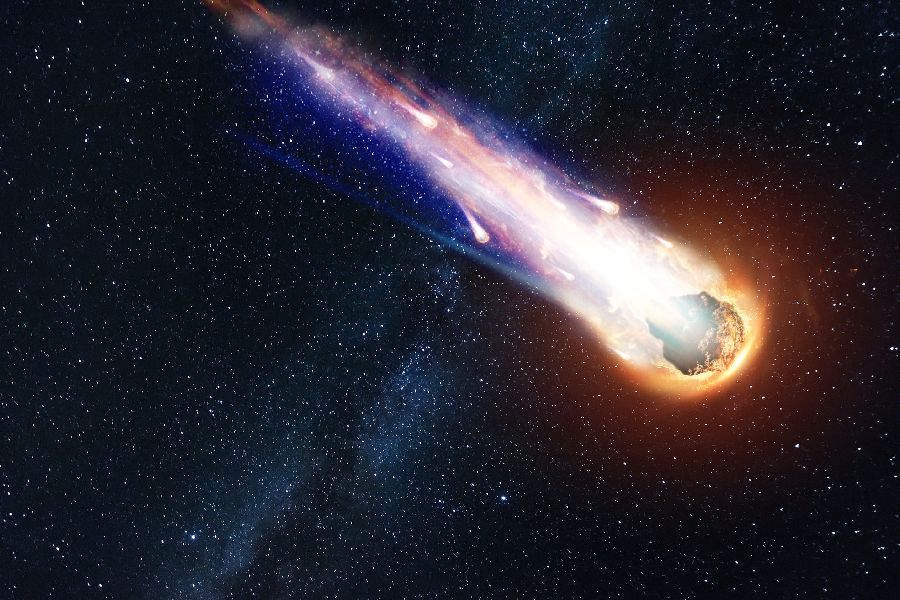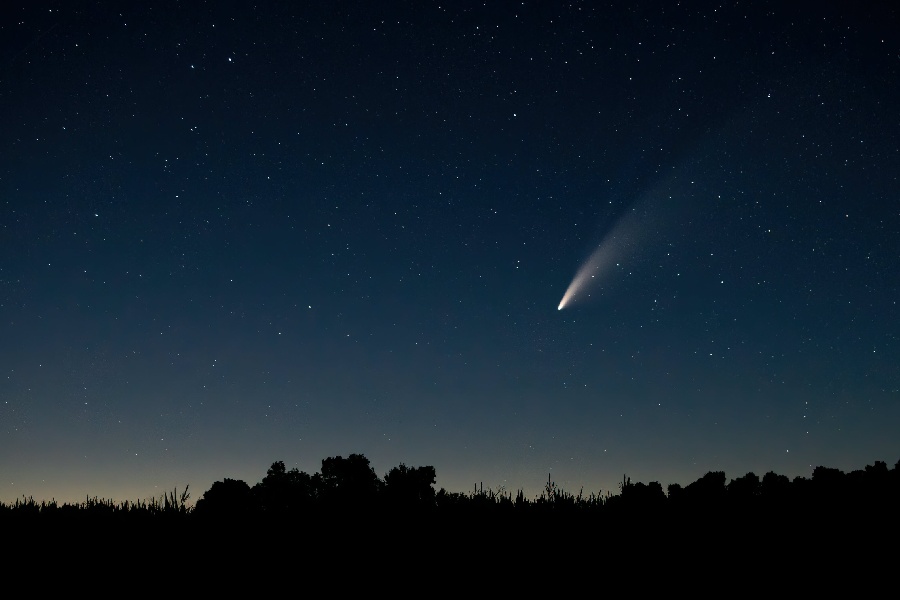Among the cosmos’s most dramatic visitors, comets have captivated humanity across cultures for eons. These icy leftovers from solar system formation put on a spectacle as they blaze near the Sun. Their glowing tails and comae offer awe-inspiring beauty for skywatchers down to the ancients who portrayed them as harbingers. What is a comet exactly, and what are its types?
Comets likely formed over 4 billion years ago in the outer solar system around the orbits of the giant planets. Preserving primordial ingredients, they get dislodged at times from these cold storage reservoirs, falling inwards towards the Sun.
These warmer orbits trigger their famed bright and flowing tails. A comet’s makeup and behavior teach us about early conditions and composition in the solar system’s evolution.
In this article, you’ll learn all about the nature of comets, those cosmic time capsules from the frigid frontiers of our stellar neighborhood.
As we explore key aspects of what a comet truly is, we’ll cover their structure, origins, and orbits, as well as the role they may play in distributing water and organic compounds to planets. We’ll also discover why they occasionally light up night skies with awesome displays as they pass near Earth’s orbit.

What Is a Comet?
What is a comet, and what do comets look like? A comet is a small celestial body composed mostly of ice, dust, and volatile gasses that forms a bright, glowing coma (a cloud of gas and dust) and often a tail when it approaches the Sun. As a comet gets closer to the Sun, heat causes the ice in its nucleus to vaporize, creating a glowing coma that reflects sunlight.
The solar wind then pushes the gas and dust away from the Sun, forming a characteristic tail that always points away from the Sun due to the force of the solar wind. Comets are considered remnants of the early solar system.
Comets are of great interest to scientists as they may contain clues about the conditions and materials present during the formation of the solar system. They follow highly elliptical orbits, spending most of their time in the distant reaches of the solar system and becoming visible only when they approach the Sun.
Unveiling the Diversity – Types of Comets
Comets are categorized into different groups based on the features of their orbits. The two main distinctions are short-period vs long-period comets and nearly-isotropic vs ecliptic comets.
Understanding the differences in comet types and their source regions gives insights into the solar system’s early makeup and current dynamics.
Examples and characteristics
Short-period comets like Halley’s Comet originate from the Kuiper Belt or scattered disk past Neptune. They orbit the Sun in less than 200 years, with some taking only a few years to complete an orbit. Their predictable periodic returns enthralled ancient skygazers.
Long-period comets from the Oort cloud can take thousands or even millions of years to orbit the Sun. In contrast to the frequent short-period visitors, they arrive unexpectedly in brilliant flashes.
Nearly-isotropic comets enter from virtually any angle, while ecliptic comets roughly align with the solar system’s flat plane. Each category expands our understanding of the primordial debris populating the outer solar system.
Anatomy of a Comet – A Cosmic Construction
Nucleus structure
A comet’s nucleus lies at the heart of the comet, serving as the icy and rocky core from which other structures emerge.
Typically a few miles across, nuclei contain dust, frozen water, ammonia, methane, and more – preserved samples of early solar system materials. Comet nuclei have irregular, porous structures resulting from their gradual formation through accreting particles.
Understanding what is the nucleus of a comet made of and what are its geologic features, gives clues into early solar nebula ingredients as well as insight into comet origins in the outer protoplanetary disk.
Comet components
What do comets look like from Earth, and why do comets glow? As a comet approaches the Sun, its nucleus heats up and spews gasses and dust into space, forming other temporary structures that give comets their allure. The coma is the transient atmosphere of gas and dust enveloping the nucleus, which can expand wider than the Sun. Comae appear hazy to telescopes, reflecting sunlight.
Comet tails form when solar radiation pressure sweeps some of this material into two long streams – an ion tail blowing straight from the Sun’s particle stream and a dust tail curving as the comet orbits. These enchanting tails may stretch across the sky, capturing the public’s wonder when comets pass near Earth. Together, the structures compose an ephemeral cosmic visitor.

Composition of the Nucleus – Secrets of the Core
Icy and rocky makeup
Comet nuclei contain a mix of ices, silicate dust, and rocks. Ices like water, carbon dioxide, carbon monoxide, and methane arrive frozen hard as rock.
Silicates and organics detected point to ingredients from across the early protoplanetary disk’s temperature zones. Nuclei likely accreted layer upon icy, dusty layer over millions of years in the cold comet nurseries.
Clues to early solar system origins
Studying how do comets form and their composition gives insights into materials and conditions present in the earliest epochs of solar system formation over 4.5 billion years ago. Their ice-to-dust ratios, silicate mineralogy, and hydrocarbon signatures serve as fingerprints to characterize distinct reservoirs across the primordial solar nebula.
Volatile elements drive activity
The ices and frozen gasses give comets their iconic bursting activity. As nuclei warm approaches the Sun, subsurface ices sublimate, venting plumes containing volatile chemicals into space.
Illuminated by sunlight, escaping carbon dioxide, cyanogen, and other gasses fluoresce in colorful displays. The streaming gasses and dust create a hazy coma and blue and white ion tails.
Tails of Glory – Dust and Gas in Comets
Dust tail formation
The curved dust tail forms when radiation pressure from sunlight accelerates fine dust particles away from the nucleus. This gives rise to the sweeping shape that seems to follow behind orbiting comets. Composed of silicates and carbon grains, these elongated dust trails glow golden yellow across the night sky.
Gas tail dynamics
The gas or ion tail traces magnetized solar wind particles ionizing gasses in the coma into a glowing plasma. Pointing almost directly away from the Sun, ion tail streams can exceed 90 million miles long.
Their spectral blue glow comes from ionized carbon monoxide stretched anti-sunward by electromagnetic forces from our star.
Origins of dust and gas
The gas and dust spewing from comets as they near the Sun originates from materials trapped within the icy nucleus over 4 billion years. Their pristine composition stands frozen in time, ready to unveil secrets about early solar system chemistry as they sublimate in transient glory around the returning icy wanderers.
Time Travelers – Short-Period and Long-Period Comets
Defining short-period comets
Comets are categorized based on their orbital period around the Sun. Short-period comets complete an orbit in less than 200 years. This includes Jupiter family comets strongly influenced by the gas giant’s gravity and Halley-type comets returning more predictably on shorter timescales.
Long-period comets unveiled
In contrast, long-period comets have extensive orbits lasting over 200 years. Hailing from the Oort cloud, they make exceptionally long journeys of thousands to millions of years around our star.
This results in rare visits to the inner solar system, producing dazzling apparitions in the night sky. Their sporadic nature captures the public imagination during show-stopping passages near Earth’s orbit and the Sun.
Conclusion
As we have explored, comets are cosmic time travelers – icy leftovers from solar system formation over 4 billion years ago. These primordial deep freeze relics offer stunning displays while unveiling clues about early conditions through their composition and behavior.
We hope this guide has illuminated that comets are more than just shooting stars in the public eye. Analyzing their structures, orbits, and eruptive processes grants revelations about past epochs in space and time.
Much remains to be learned about what is a comet by tracking their episodic returns through night skies. Yet, with each blazing appearance, their glowing tails rewrite the epic narrative of our stellar neighborhood’s origins one orbit at a time.
